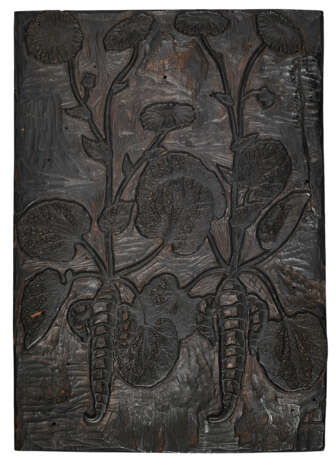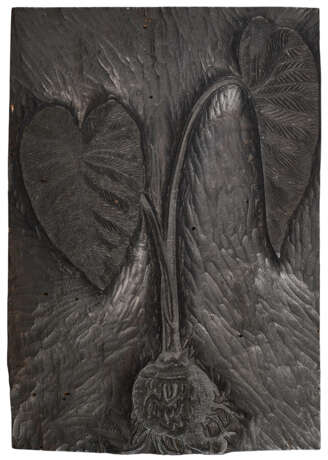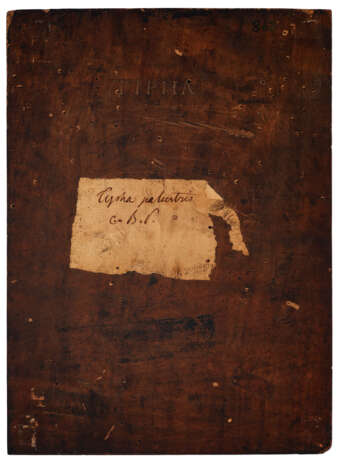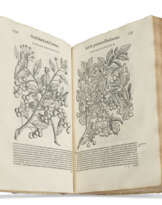ID 1032740
Lot 88 | Four original woodblocks from the celebrated Mattioli Herbal
Estimate value
$ 25 000 – 35 000
Four pear wood blocks (220 x 157mm). Paper labels by Duhamel Du Monceau on verso, with his inscriptions in ink giving plant names based on Caspar Bauhin’s Pinax; woodcutter’s knife trial marks on versos of blocks (light worming, as usual, not impairing the image).
Four original woodblocks used for one of the greatest series of woodcut botanical illustrations of the sixteenth century—among the most important surviving sixteenth-century printing surfaces, and the only major scientific woodcut blocks existing from that period.
The Mattioli blocks were the culmination of technical virtuosity in botanical woodcut design, being images “of considerable size and unprecedented complexity ... morphologically detailed and carefully shaded images whose style contrasts notably with the airy, simple elegance of Fuchs’ illustrations” (Bridson and Wendel).
The designer, Giorgio Liberale, was an Italian artist employed by the Imperial court in Prague, where Pier Andrea Mattioli served as Imperial physician to Ferdinand I and his son Archduke Maximilian (later Emperor Maximilian II); Meyerpeck, who cut the blocks, was a German artist also active in Prague. Mattioli’s famous herbal is ostensibly a commentary on the ancient treatise of Dioscorides, but in fact is so much more: it translates Dioscorides for the early modern era, and adds descriptions of many new plants, from across Europe and Asia as well as from the Americas. It would become the most frequently reprinted herbal of the sixteenth century, but is chiefly celebrated today for a small number of its editions illustrated with the “large” suite of woodblocks designed by Liberale and Meyerpeck, represented by the examples in the current lot.
The first appearance of these cuts was in the Czech edition printed in Prague in 1562; a German version, New Kreuterbuch, was also published in Prague in 1563. For the Italian edition, printed in Venice by Valgrisi, further woodcuts were added, not only more plants but also fauna and genre scenes. This edition was reprinted, with expanded commentary, in 1583. Almost all other illustrated editions utilized smaller images (see lots 85 and 86). Three of the blocks here were first published in Prague in 1562, the subsequent German edition of 1563, and then in the first Venice edition of 1565; all produced by Valgrisi and his Prague publishing partners. The block depicting the Arum first appears in the 1565 edition.
In the 18th-century, the French botanist Duhamel du Monceau (1701-1788) acquired the majority of the suite, using 154 of them to illustrate his Traité des arbres et arbustes in 1755. These 154 have never been seen again (they may not have survived the printing process); but the remaining blocks remained with Duhamel’s descendants until 1956, at which time several were dispersed.
In 1988 Niall Hobhouse, Bernard Quaritch Ltd, and Antiquariaat Junk b.v. acquired a cache of 110 blocks. These four blocks have never before been offered for sale. Remarkably, the majority of the blocks were (and still are) printable from, and a small number of prints were struck off for a special publication. See Watson, Raphael, and Bain, The Mattioli Woodblocks (London, Bernard Quaritch, 1989) for a full listing and discussion of the history, and especially Iain Bain’s "Technical note on the blocks;" see also Bridson and Wendel, Printmaking in the service of botany (1986), p. 25.
| Artist: | Pietro Andrea Gregorio Mattioli (1501 - 1578) |
|---|---|
| Place of origin: | Italy |
| Auction house category: | Medicine & science, Printed books |
| Artist: | Pietro Andrea Gregorio Mattioli (1501 - 1578) |
|---|---|
| Place of origin: | Italy |
| Auction house category: | Medicine & science, Printed books |
| Address of auction |
CHRISTIE'S 20 Rockefeller Plaza 10020 New York USA | ||||||||||||||
|---|---|---|---|---|---|---|---|---|---|---|---|---|---|---|---|
| Preview |
| ||||||||||||||
| Phone | +1 212 636 2000 | ||||||||||||||
| Fax | +1 212 636 4930 | ||||||||||||||
| Conditions of purchase | Conditions of purchase | ||||||||||||||
| Shipping |
Postal service Courier service pickup by yourself | ||||||||||||||
| Payment methods |
Wire Transfer | ||||||||||||||
| Business hours | Business hours
|










![Original woodblock for Cardus vulgaris [Carline Thistle], from Mattioli's Herbal](/assets/image/picture_3695516/68cbd/cqlj4tbszqrc9o4s3dm7r33zwlyrppuqo6jrdu2q-kmvpkdyo4ojenv0-kraijme1704446647jpg__fix_162_205.jpeg)
![Original woodblock for Aquilina Aquilegia vulgaris [Columbine], from Mattioli's Herbal](/assets/image/picture_3134701/0a041/lnv8185xrdrbubgr19jqdblnlhre59zep63yalv4j3kvcxzvw4sxwbmfqdwtkbkk1695820581jpg__fix_162_205.jpeg)


